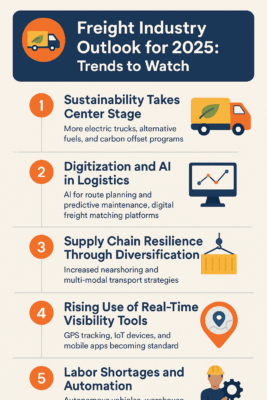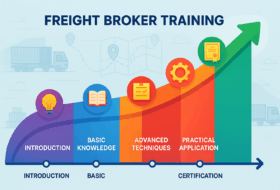Freight Industry Outlook for 2025: Trends to Watch
In the fast-paced world of freight dispatching, efficiency is key to ensuring smooth operations and customer satisfaction. One of the most effective ways to optimize freight dispatching is by staying informed on where the industry is headed. As we move into 2025, the freight industry is experiencing a significant transformation driven by digital innovation, sustainability goals, and shifting global trade dynamics. Understanding these trends is crucial for companies looking to remain competitive in a rapidly evolving logistics landscape.
Why Staying Ahead of Trends Matters in the Freight Industry
Staying informed about industry shifts allows freight dispatchers, carriers, and shippers to anticipate market demands, adapt operations, and make proactive business decisions. With 2025 bringing new challenges and opportunities, keeping a finger on the pulse of the freight industry is no longer optional—it’s a necessity for survival and growth.
Here are 5 Key Trends Shaping the Freight Industry in 2025:
1. Sustainability Takes Center Stage
Environmental concerns are pushing logistics companies to adopt greener operations. Expect more electric trucks, increased use of alternative fuels like biodiesel and hydrogen, and investment in carbon offset programs. Governments around the world are implementing stricter emissions regulations, encouraging the freight industry to modernize its fleets and reduce its carbon footprint.
2. Digitization and AI in Logistics
Technology is transforming how freight is dispatched, tracked, and managed. Artificial intelligence (AI) is now used to predict delays, automate route planning, and even anticipate maintenance issues in vehicles. Digital freight matching platforms are making it easier to connect loads with carriers, saving time and reducing empty miles.
3. Supply Chain Resilience Through Diversification
The COVID-19 pandemic and recent geopolitical events have exposed vulnerabilities in global supply chains. In 2025, more companies are investing in supply chain diversification, nearshoring, and multi-modal transport strategies. This shift is altering traditional freight lanes and increasing demand for regional freight services.
4. Rising Use of Real-Time Visibility Tools
Shippers and customers now expect real-time updates on their shipments. GPS tracking, IoT devices, and mobile apps are becoming standard in freight operations. These tools provide transparency, enhance customer service, and help dispatchers make informed decisions faster.
Real-time visibility is particularly useful for identifying bottlenecks, avoiding delays, and maintaining high service levels. As this becomes the norm, companies without real-time tracking will fall behind.
5. Labor Shortages and Automation
The driver shortage continues into 2025, with fewer new drivers entering the industry and many veterans retiring. To combat this, companies are investing in autonomous vehicle technology, warehouse automation, and enhanced driver retention strategies, including better pay and work-life balance initiatives.
How Freight Dispatchers Can Prepare for 2025
To stay competitive in the freight industry, dispatchers and logistics managers should:
- Invest in Technology: Choose freight management software that includes real-time tracking, automated load matching, and data analytics.
- Build Carrier Relationships: Reliable carriers are in high demand. Prioritize building long-term partnerships and offering fair rates.
- Train Staff: Equip dispatchers with skills in tech tools, data analysis, and customer communication.
- Focus on Sustainability: Collaborate with eco-conscious carriers and consider switching to low-emission equipment where possible.
The Future of the Freight Industry
By 2025, the freight industry will be more digital, data-driven, and sustainability-focused than ever before. Companies that embrace these trends will benefit from improved efficiency, lower costs, and stronger customer relationships. Those who resist change risk falling behind in a market that rewards adaptability and innovation.
Conclusion
As we look ahead to 2025, the freight industry is undergoing a significant transformation. From green logistics and AI-powered tools to real-time visibility and labor innovations, the landscape is shifting rapidly. To optimize freight dispatching and remain competitive, freight companies must stay agile, invest in modern solutions, and focus on long-term resilience. Those who do will be well-positioned to thrive in the future of freight.
FAQ
Q: What is the biggest challenge for the freight industry in 2025?
A: Labor shortages and adapting to sustainability regulations are major challenges that companies need to address proactively.
Q: How is technology helping the freight industry?
A: Technology improves route planning, tracking, automation, and data analysis, leading to greater efficiency and transparency.
Q: Is the freight industry going green?
A: Yes, sustainability is a key trend with growing investment in electric vehicles, fuel alternatives, and eco-conscious operations.
Enroll Today and join thousands of students who’ve turned their dreams into reality.
Growth + Change = Opportunity! How are you going to capitalize on the opportunity as a freight broker, agent, dispatcher or box truck carrier?
Enroll in a course today and get a Shippers List for free! Use Code: freeship






